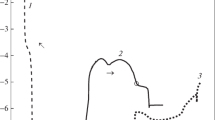Abstract
We consider the evolution of binary systems formed by a Supermassive Black Hole (SMBH) residing in the center of a galaxy or a globular cluster and a star in its immediate vicinity. The star is assumed to fill its Roche lobe, and the SMBH accretes primarily the matter of this star. The evolution of such a system is mainly determined by the same processes as for an ordinary binary. The main differences are that the donor star is irradiated by hard radiation emitted during accretion onto the SMBH; in a detached system, nearly all the donor wind is captured by the black hole, which strongly affects the evolution of the semi-major axis; it is not possible for companions of the most massive SMBHs to fill their Roche lobes, since the corresponding orbital separations are smaller than the radius of the last stable orbit in the gravitational field of the SMBH. Moreover, there may not be efficient exchange between the orbital angular momentum and the angular momentum of the overflowing matter in such systems. Our computations assumed that, if the characteristic timescale for mass transfer is smaller than the thermal timescale of the star, no momentum exchange occurs. Absorption of incident external radiation in the stellar envelope was treated using the same formalism that was used when computing the radiative transfer in the stellar atmosphere. Numerical simulations show that Roche-lobe overflow is possible for a broad range of initial system parameters. The evolution of semi-detached systems containing a star and a SMBH nearly always ends with the dynamical disruption of the star. Stars with masses close to the solar mass are destroyed immediately after they fill their Roche lobes. During the accretion of matter of disrupted stars, the SMBH can achieve quasar luminosities. If the SMBH accretes ambient gas as well as gas stripped from stars, the star is subject to additional radiation in the detached phase of its evolution, strengthening its stellar wind. This leads to an increase of the semi-major axis and subsequent decrease of the probability of Roche-lobe overflow during the subsequent evolution of the system.
Similar content being viewed by others
References
L. Chao, W. Bian, and K. Huang, Adv. SpaceRes. 42, 544 (2008).
Y. Wang, T. Yamada, and Y. Taniguchi, Astrophys. J. 588, 113 (2003).
C. L. Steinhardt and M. Elvis, arXiv:0911.1355 [astro-ph] (2009).
Y. Shen, Astrophys. J. 704, 89 (2009).
K. Coppin, A. Swinbank, R. Neri, et al., Mon. Not. R. Astron. Soc. 389, 45 (2008).
A. E. Broderick and R. Narayan, Astrophys. J. 638, L21 (2006).
G. Ghisellini, L. Foschini, M. Volonteri, et al., Mon. Not. R. Astron. Soc. 399, L24 (2009).
P. Amaro-Seoane and M. Freitag, Astrophys. J. 653, 53 (2006).
S. Umbreit, J. M. Fregeau, and F. A. Rasio, arXiv:0910.5293 [astro-ph] (2009).
M. Mapelli, Mon. Not. R. Astron. Soc. 376, 131 (2007).
P. Hopkins, R. Somerville, L. Hernquist, et al., Astrophys. J. 652, 864 (2006).
W. Oegerle and J. Hill, Astron. J. 122, 2858 (2001).
D. Mortlock, M. Patel, S. Warren, et al., Astron. Astrophys. 505, 97 (2009).
A. Venkatesan, R. Schneider, and A. Ferrara, Mon. Not. R. Astron. Soc. 349, L43 (2004).
M. Wardle and F. Yusef-Zadeh, arXiv: 0805.3274 [astro-ph] (2008).
D. Figer, arXiv: 0803.1619 [astro-ph] (2008).
L. Young, G. Bendo, and D. Lucero, arXiv: 0803.4510 [astro-ph] (2008).
T. Boker, J. Falcon-Barroso, E. Schinnerer, et al., arXiv: 0710.4036 [astro-ph] (2007).
A. V. Tutukov and A.V. Fedorova, Astron. Zh. 86, 449 (2009) [Astron. Rep. 53, 410 (2009)].
L. E. Strubbe and E. Quataert, arXiv: 0905.3735 [astro-ph] (2009).
J. Magorrian and S. Tremaine, Mon. Not. R. Astron. Soc. 309, 447 (1999).
A. G. Masevich and A. V. Tutukov, Stellar Evolution: Theory and Observations (Nauka, Moscow, 1988) [in Russian].
B. Paczynski, Ann. Rev. Astron. Astrophys. 9, 183 (1971).
O. Vilhu, E. Ergma, and A. Fedorova, Astron. Astrophys. 291, 842 (1994).
A. V. Tutukov, A. V. Fedorova, E. V. Ergma, and L. R. Yungel’son, Pis’ma Astron. Zh. 11, 123 (1985) [Sov. Astron. Lett. 11, 52 (1985)].
A. V. Tutukov, A. V. Fedorova, E. V. Ergma, and L. R. Yungel’son, Astrofizika 24, 85 (1986).
A. V. Fedorova and E. V. Ergma, Astrophys. Space Sci. 151, 125 (1989).
A. V. Tutukov and A. V. Fedorova, Astron. Zh. 66, 1172 (1989) [Sov. Astron. 33, 606 (1989)].
A. V. Tutukov and A.V. Fedorova, Astron. Zh. 79, 847 (2002) [Astron. Rep. 46, 765 (2002)].
A. R. King, in Black Holes in Binaries and Galactic, Ed. by L. Kaper, E. P. J. van den Heuvel, and P. A. Woudt (Springer, Berlin, 2001), p. 155.
L. D. Landau and E. M. Lifshits, Course of Theoretical Physics, Vol. 2: The Classical Theory of Fields (Nauka, Moscow, 1988; Pergamon, Oxford, 1975).
Author information
Authors and Affiliations
Additional information
Original Russian Text © A.V. Tutukov, A.V. Fedorova, 2010, published in Astronomicheskiĭ Zhurnal, 2010, Vol. 87, No. 9, pp. 878–894.
Rights and permissions
About this article
Cite this article
Tutukov, A.V., Fedorova, A.V. Close binaries containing Supermassive Black Holes. Astron. Rep. 54, 808–822 (2010). https://doi.org/10.1134/S1063772910090052
Received:
Accepted:
Published:
Issue Date:
DOI: https://doi.org/10.1134/S1063772910090052



